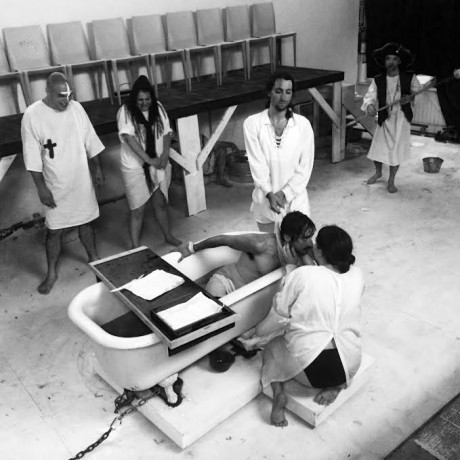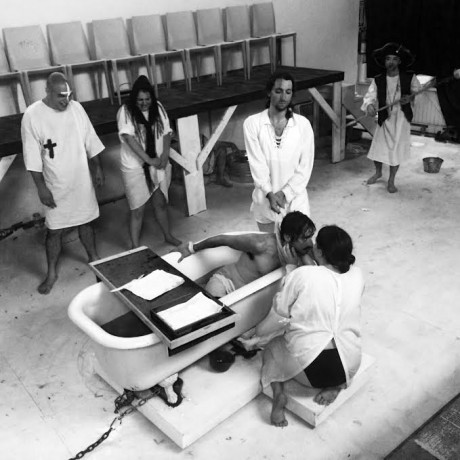My Lords and Ladies of Baltimore:
You are most cordially invited by Director Coulmier, and his wife Lady Coulmier, to attend a fine performance presented at the Asylum of Charenton (The Baltimore Annex Theater’s previous life in 1808.) The play, taking place but 15 years ago in 1793 is written by Monsieur de Sade, a current resident of the asylum and is being performed willingly by the inmates as a part of the astoundingly progressive “Arts Therapy” program.

It has been ensured by Master Frederick Gerriets (a proper designer of theatrical settings, if you will) that proper seating will be provided for those attending the performance in the asylum. So as not to disturb the art therapy practices, seating banks have been constructed just above the main asylum floor; an observation deck on either side of the space being used as a stage. The asylum is naturally the starkest of whites to promote calm and relaxing behavior among the patients.
Ensuring that the patients of the asylum are most comfortable in the latest of reasonable asylum fashions, Master Philip Doccolo (a proper designer of theatrical costumes, if you will) has provided the inmates with standardized white hospital gowns to keep them calm and collected for the performance. Lord and Lady Coulmier also have their laundry handled by Master Doccolo who provides them with the utmost fashionable garments of high society.
Conceptualizing such an immersive experience is no small task, and was thusly arranged by the unseen Chairpersons of the asylum (a proper pair of theatrical directors, if you will) Master Philip Doccolo and Madame Sarah Heiderman. Together, the efforts of Master Doccolo and Madame Heiderman have proven to be a great success in orchestrating a truly phenomenal experience. To walk among the rehabilitating— those suffering from any number of mental maladies— and experience a theatrical endeavor at their behest is a most intriguing evening and leaves the mind wondering just what else could be achieved when the right mind is set to the task. Master Doccolo and Madame Heiderman are to be commended for their tremendously successful efforts in executing such a behemoth of a project; particularly in corralling the plethora of unique individuals into working order for the performance.
Worry not for your safety nor your own sanity as the staff of Charenton is quite on point to keep the inmates in line. Sister (who before taking her vows was known as Ayllson Washington) keeps a close eye on the patients, ensuring their proper conduct amongst each other and as they partake in the production. Sister Washington is often a calming presence to the patients, particularly the young lady who is cast in the role of Charlotte Corday in Monsieur de Sade’s production.
Also on hand is thuggish strength in the form of Charenton’s Head Orderly (who is oft referred to as Reuben Kroiz.) Mister Kroiz gives not a nut for the spoken word but keeps peace among the patients, particularly those who get out of hand, and his sheer mass and strength contained therein is enough to frighten any wayward behavior out of existence.
As for Lord Coulmier (who was believed to be the rapscallion Rex Anderson before arising properly in high society) and his Lady Coulmier (also a harlot of the streets by the alias Kris Hanrahan before taking to marrying the rakish Rex) they do their utmost best to maintain the condition of the asylum and its patients. Lord Coulmier does struggle, however, at times during de Sade’s performance in the asylum, to keep his composure. It is clear that the knavish impulses of Mr. Anderson wish to surge through him and the good Director of the asylum channels these urges into anti-revolutionary outbursts at the most inopportune moments, often disrupting the critical work that de Sade is striving so hard to complete. It is a fascinating endeavor to watch both Lord and Lady as they watch the production; their facial responses hardly restrained as good manners of proper society would indicate. And mindful of Lady Coulmier toward the end of the evening’s entertainments as de Sade clearly has other intentions for this woman.
Various and sundry patients galore, each in their own give a respectable performance within the production. Owing to the fact that there are far more names than space provided for this official write-up of such clever endeavors, I entreat you to experience the performance first hand so that these inmates can better make your acquaintance with all of their quirks. That said, there are, however, several inmates of noteworthy reckoning, if so that nothing else, you are prepared.
Inmates Bradley Bukowsky and Kristina Green have the most terrifying dead stares that often make them appear possessed. Bukowsky is granted a role in Monsieur de Sade’s performance, but Green is deemed far too disturbed to have a speaking part of import. The pair are notable and best observed from a distance to keep one from experience goose pimples and other unpleasant sensations.
The same can be said of a quartet of inmates that become streetwise clowns in de Sade’s performance. Inmates Jacob Budenz, Matthew Casella, Corey Hennessey, and Siobhan Beckett often lead the nightmarish singing and dancing that is an integral part of de Sade’s work at the asylum. Beckett, despite her genuinely creepy nature, has a most delicate voice used for starting songs. This quartet of curious patients is as disturbing and as disturbed as the aforementioned inmates and again best observed from a distance.
It is a pair of unfortunate inmates who have landed themselves the key instruments in Monsieur de Sade’s work. Lady Molly Margulies, a victim of sleeping sickness, has landed herself in the staring female role of Charlotte Corday. Mademoiselle Margulies shuffles about the asylum, aided constantly by Sister Washington, perpetually in a dreamlike state, though I am apt to believe it is an unending nightmarish cycle of disturbia in which she lives. The inmate Trevor Wilhelms is equally unfortunate, deluded into believing he’s a catatonic fish as he seldom rises from his tepid bathtub. This, however, made him the perfect candidate in de Sade’s eyes to play Jean-Paul Marat. Monsieur Wilhelms does rile to life quite quickly, particularly when engaged by de Sade throughout the course of the performance; a stunning and haunting theatrical experience if ever there was one.
As for the true master behind this madness, the Marquis de Sade (who might simply be the Charenton Chairperson of the board Philip Doccolo masquerading in trumped up guise) – well his madness is evident in every fiber of his being. Between the nasally, reedy voice that speaks his every word to his furiously intense gazes, this de Sade fellow is of a queer and unnatural variety, terrifying enough to set one’s teeth on edge! The presence that he commands, particularly given that during nearly the first half of this orchestration he is completely silent, is stunning. His movements are captivating, and his general approach to both the play and his insertion therein are spine-tingling and horrifyingly exciting. ‘Tis more strange still to think that this man of such great import is but a simple Chairperson and Costume Launderer, succeeding so well as he does in the role of lead actor. He is not a man to be trifled with; a performance most titillating, albeit disturbing in the most unsteady of senses.
I implore you to investigate this production at your leisure. A formal invite has been issued, and now as a good denizen of the time and place, you must heed the call. It is assured that your safety is guaranteed and in the unlikely event of a true revolution among the inmates, there is always the Head Orderly and the rest of the quaint staff at Charenton to keep things in order. But the chances of two revolutions in one evening are simply unheard of, aren’t they?
Running Time: 2 hours and 20 minutes with one intermission
The Persecution and Assassination of Jean-Paul Marat As Performed by the Inmates of the Asylum of Charenton Under the Direction of The Marquis de Sade plays through August 3, 2014 at The Baltimore Annex Theater at Station North Chicken Box— West North Avenue, in Baltimore, MD. Tickets can be purchased at the door, or in advance online.

